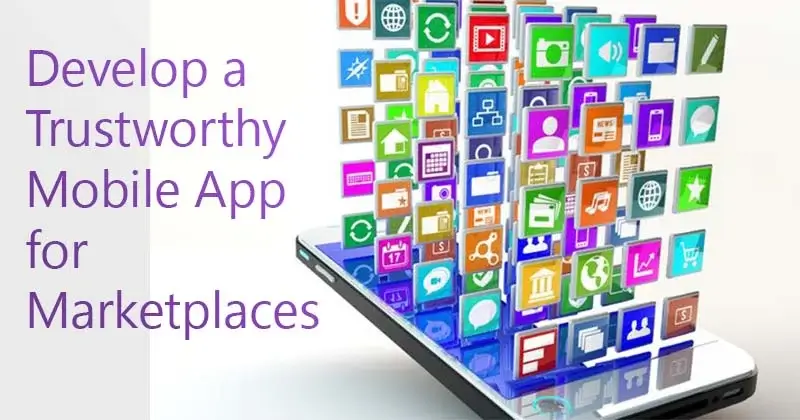In the revolutionary market of mobile applications, trustworthiness is the foundation to ensure optimal user engagement and satisfaction. The trust factor in mobile apps is defined by their ability to secure user data while maintaining a reliable performance. Therefore, every ecommerce app development company is more focused on building user trust with the features offered for marketplace apps.
Trust holds a great significance for any medium in any trait of business and this goes the same for mobile apps in the marketplace. It serves as the anchor to ensure user adoption by building confidence in financial transactions to maintain a solid brand image.
Today, businesses are more inclined towards any famous Android application development company that prioritizes the user’s data security and privacy, providing an edge in the competitive app market.
10 Strategies to Cultivate Trust in Marketplace Apps
Building trust among the marketplace application is the primary concern to ensure user engagement and retention. These efficient strategies enable securing authentication and implementing transparent policies to maintain the reliability of transactions. Here, we will delve into these strategies, providing actionable insights for developers and businesses seeking to build and maintain trust in their marketplace apps.
1- Secure Authentication and Authorization
You can implement two-factor authentication and add an extra layer of security. It requires users to verify their identity through a second method, such as a code sent to their mobile device. This significantly enhances account security, reducing the risk of unauthorized access.
Meanwhile, the integration of OAuth for third-party logins allows users to access your marketplace app using their existing credentials from trusted platforms like Google or Facebook. It simplifies the login process while leveraging the robust security measures of these established platforms.
Always communicate the security features of your app to users with complete transparency. You should clearly outline the authentication methods used, data encryption practices and any other security protocols.
2- Secure Transactions
Encrypt the financial transactions by integrating reputable and secure payment gateways. It ensures that users’ payment information is protected, meeting industry standards for secure online transactions.
Meanwhile, it is essential to comply with the Payment Card Industry Data Security Standard (PCI DSS). That’s how you can guarantee the secure processing of credit card information. You can minimize the risk of data breaches and build the trust users place in your app with compliance with these standards.
Moreover, the implementation of Secure Socket Layer (SSL) or Transport Layer Security (TLS) protocols is crucial for encrypting data transfers between users and servers.
3- User Data Protection
It is a good practice to communicate your app’s privacy policies transparently. Consider every detail about how user data is collected, used and stored. You can also provide users with clear insights into the purpose behind data collection and the measures taken to protect their privacy.
Moreover, it is advised to collect only the essential user data required for app functionality. That’s how you can minimize the potential impact of a data breach. You can also implement robust encryption methods to protect stored user data from unauthorized access.
4- Transparent Policies
Always keep clear communication with the users regarding their data usage, storage and sharing. You can transparently disclose the purposes behind data usage, ensuring users are well-informed about their information.
Moreover, you can establish clear policies regarding refunds, cancellations and any updates within the application. It helps you to gain the customers’ trust by providing clarity on these matters ensuring a commitment to fair business practices.
5- User Verification and Reviews
Integrate robust user verification systems to ensure the authenticity of users. It minimizes the risk of fraudulent activities and enhances the overall safety of transactions within the marketplace.
For that purpose, you can enable a system for users to leave reviews and ratings. These authentic user feedbacks build trust and help potential users make informed decisions about transactions.
Moreover, you need to take proactive measures to detect and address fraudulent activities right away. These precautions may include automated systems and machine learning algorithms to identify potential risks.
6- Customer Support
You can include easily accessible customer support channels, such as in-app chat, email or phone support to run smooth operations. It proves your commitment to customer satisfaction with prompt responsiveness to user inquiries.
Therefore, you should display contact information and specify the response times. Transparent communication about support availability and turnaround times helps manage user expectations.
So, you can address user concerns and issues promptly. The on-time resolution of problems demonstrates a commitment to customer satisfaction and helps maintain a positive user experience.
7- App Performance and Reliability
To ensure smooth and efficient user experiences, you must prioritize app performance and reliability. Considering this approach, you can minimize downtime, optimize loading times and regularly test the app’s functionality to identify any potential issues.
You can also enhance security, and introduce new features by frequently updating the app to fix bugs. However, regular updates show users that the app is actively maintained and that their security is a top priority.
It is essential to communicate updates and improvements to users through in-app notifications. That’s how you can maintain transparency and help them understand that the app is evolving for the better.
8- Legal Compliance
Ensure that your ecommerce app is developed through compliance with relevant laws and regulations. There are several regulatory aspects governing data protection, consumer rights, and any other applicable legal standards. Legal compliance is the key to building trust and credibility.
So, you must communicate legal terms and conditions to users. It includes terms of service, privacy policies and any contractual agreements that you can show on your app.
9- Insurance and Risk Mitigation
You can explore different insurance options to reduce the risks associated with any accidental event considering financial transactions and data breaches. So, insurance helps financial safety and provides an added layer of protection for your business and users.
Therefore, you can implement risk mitigation strategies specific to financial transactions in your ecommerce app. It can also include transaction monitoring, fraud detection systems, and collaboration with financial institutions to minimize the impact of fraudulent activities.
10- Feedback and Continuous Improvement
User feedback is quite valuable for identifying areas of improvement and gaining insights about the user’s expectations. So, always encourage users to provide feedback on their experiences with the app.
You must figure out different ways to improve the app based on user feedback, market trends and emerging technologies. That’s how you can demonstrate a commitment to continuous enhancement that builds trust and loyalty among users.
Communicate your commitment to continuous improvement with interactive action within the app. Whether through regular app updates or announcements, make it clear that you actively listen to user feedback and make efforts to enhance overall performance.
Conclusion
In the competitive world of mobile apps, trust is crucial for user satisfaction, especially in ecommerce. Trust is based on protecting user data and ensuring reliable performance. Meanwhile, efficient strategies involve securing authentication, transparent policies and protecting transactions. Implementing measures like two-factor authentication, clear privacy policies and secure payment gateways builds user trust. Features such as user verification, accessible support and continuous improvements reinforce the app’s commitment to user satisfaction and security. Trust isn’t just a feature in marketplace apps; it’s a strategic necessity that can make businesses stand out in the app market.



